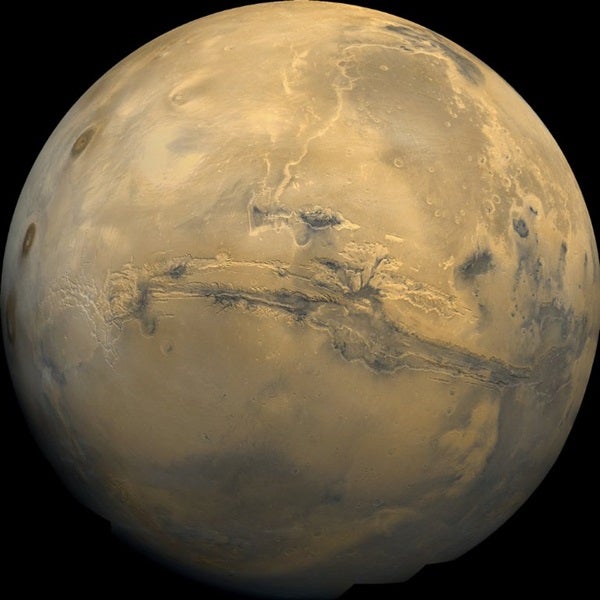Transcript
Mars appears as a red glow to the naked eye. It’s named after the Roman god of war because its rusty appearance reminded the ancients of blood. So what causes the red color? The planet’s dust contains iron oxide, which is rust.
The Red Planet is 4,221 miles (6,793 kilometers) wide, which corresponds to roughly half the width of Earth. It contains just over 10 percent of our planet’s mass. Mars’ orbit takes it within about 1.38 times the Earth-Sun distance at closest approach. Its farthest point is at roughly 1.67 times the Earth-Sun distance, and it takes nearly 687 Earth days to complete this orbit. Mars’ day is just 39.6 minutes longer than ours.
This image shows one of the Red Planet’s most recognizable features. The gash across the disk is Valles Marineris, the largest canyon in the solar system. It extends more than 1,860 miles (3,000 kilometers) long and perhaps 5 miles (8 kilometers) deep. Compare that to Earth’s Grand Canyon in Arizona, which is about 500 miles (800 kilometers) long and 1.1 miles (1.8 kilometers) deep. Astronomers made this composite using 102 images taken by the Viking 1 orbiter in 1980.
While Mars is geologically inactive now, astronomers see evidence of a much more turbulent past. Giant volcanoes dot the surface, and most craters are younger than 1 billion years.
The thin martian atmosphere prevents water from existing on the planet’s surface today. It would evaporate almost immediately. However, astronomers have strong evidence that the Red Planet used to have liquid water. From networks of dried river channels to tumbled and smoothed BB-sized rocks, the martian surface is rife with examples of past water.
The Mars Exploration Rovers Spirit and Opportunity found evidence of water in layered rock outcrops and other sources, too. Both rovers lasted far longer than their expected 3-month mission. Opportunity investigated roughly one-quarter of the way around Victoria Crater, an impact site some 800 yards (730 meters) wide. The scalloped edges indicate that wind erosion has widened the once smaller crater over time. Opportunity also took this panoramic image of the crater from an alcove called Duck Bay. The rover entered the crater from this point to examine rock layers. Fortunately, Opportunity was able to climb out and is still going strong on Mars.
Unfortunately its twin rover, Spirit, has ceased exploration. Nearly 5 years and 4 months after landing on Mars, Spirit got stuck in soft soil. Scientists have been unable to free the rover, and communication has ceased.
The Red Planet harbors water ice at its northern and southern polar caps. This image from NASA’s Mars Global Surveyor shows the 620-mile-wide (1,000 kilometers) northern cap. More-recent missions have also found water ice below the martian surface.
The Mars Reconnaissance Orbiter, which launched in August 2005, has observed ice in fresh craters. And Phoenix, a martian lander that operated on the surface near the north polar cap from May to November 2008, studied the Red Planet’s surface soil and weather patterns.
The next missions will continue the search for past or present life. NASA’s Curiosity rover, which is scheduled to launch in November, 2011, is one of the most anticipated. The fact that water existed on Mars is well accepted as an indicator that the Red Planet might hold evidence of once-living organisms.










